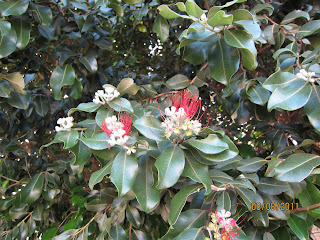
After Catherine and I share some Rosen Sessions at the Quaker Meeting House on Devonshire St, she introduced me to her partner Dennis who is a music teacher that moved to Australia in the 1970's. We had a breakfast down the street and then hopped on the train to the Tempe Station south of the airport near Botany Bay. Catherine has worked in a bush restoration project here to retain native species in the TVT, Twin Valleys Trail, Wolli (pronounced walleye) Creek and Cook River, after Capt. Cook. Here is the beginning of the trail going south. I keep getting turned around here, as the sun is in the north! :-) This is a photo of where the two meet with a couple of the water birds. This is a tidal river with salt water.

Many of the native species have names new to my American ears. What I call acacia is here called "wattle". So here is a species with very interesting leaves we encountered early on the trail.

These strings of hanging pink and white bells are also a native. Stunning too.

This is another native plant to Australia. Catherine is a native of 30 miles N of Sydney and told me the name of this stunning flower with the long red stamens coming out and I forgot to write it down. Anyway, fun to know this is one of the real Australian non introduced species.

This is the fruit of Banksia serrata, I big old tree we discovered had several of these. The wood of this species from the east coast is known for its beautiful grain. The hard capsules hold a winged seed that usually needs heat to open. The fires set by aboriginal peoples allowed these to open and reseed.

Here are Dennis and Catherine on the trail when Dennis decided to take the train from an different station to practice his flute for a quartet performance.

This is a peaceful overlook of Wolli Creek where we sat and listened to the birds. I did see a pair of blue wrens prior to this and
many ibis were on the green area, that made some amazing sounds. All so new to my ears! And the smells of the eucalyptus type trees.

No comments:
Post a Comment